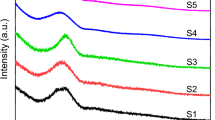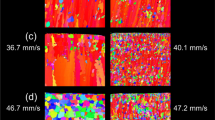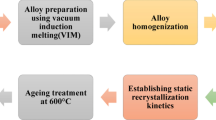Abstract
Solidification microstructures of aluminium silicon alloy (A-356) containing 0, 10, 15 and 20 vol % silicon carbide particles formed during directional solidification from a chill have been studied and compared with the structures obtained during solidification of the base alloy under similar mould and chill conditions. Columnar dendritic structure was observed during solidification of the base alloy at all distances from the chill. In the case of composites, the presence of silicon carbide particles disturbs the orderly aligned arrangement of dendrites observed in the base alloy, under similar solidification conditions, except near the chill surface where a particle-free zone is observed due to probable pushing of particles by the macroscopic solidification front with cell spacings finer than the particle size. During the entire range of solidification conditions studied in this work, the silicon carbide particles are pushed by growing dendrites of α-aluminium into the last freezing eutectic liquid. The observations on pushing of silicon carbide particles have been examined in relation to existing models on particle pushing by planar solidification fronts. Even in the regions away from the chill, where silicon carbide particles are present, there are large regions covering several dendrite arm spacings where there are no particles representing another form of macrosegregation of particles. It is observed that the secondary dendrite arm spacings (DAS)of α-aluminium are related to cooling rate by an equation DAS =b (T) n for the base alloy as well as for the composite. The coefficientb is generally higher for composites than for base alloy, and it is found to be a function of particle content. The value ofn for the composite is close to the value of the base alloy and is not significantly influenced by the presence of particles. Cooling rate, temperature gradients and the rate of advancement of the solidification front have been experimentally measured for the base alloy as well as for the composites during unidirectional solidification. The study indicates that the presence of particles themselves alters the cooling rates, temperature gradients and growth rate of the macroscopic solidification front under identical thermal surroundings during solidification. The possible influences of these alterations in growth condition on the solidification microstructure due to the presence of particles are discussed together with the other possible direct influences of particles on dendritic growth of aluminium-silicon alloys.
Similar content being viewed by others
References
P. K. ROHATGI,J. Metals 43 (1991) 10.
M. K. AGHAJANIAN, J. T. BURKE, D. R. WHITE and A. S. NAGELBERG,SAMPE Quarterly 34 (1989) 817.
S. RAY,Ind. J. Technol. 28 (1990) 77.
O. KENNEDY,Adv. Mater. Proc. 6 (1991) 42.
P. K. ROHATGI, R. ASTHANA and S. DAS,Int. Met. Rev. 31 (1986) 115.
P. K. ROHATGI and R. ASTHANA,J. Metals 43 (1991) 35.
M. SKIBO, D. L. MORRIS and D. J. LLOYD, in “Proceedings of the Conference on Cast Reinforced Metal Composites”, edited by S. G. Fishman and A. K. Dhingra (ASM, Metals Park, OH, 1988) p. 257.
M. A. BAYOUMI and M. SUERY,ibid. in “, p. 167.
M. SUERY and L. LAJOYE, in “Solidification of Metal Matrix Composites”, edited by P. K. Rohatgi (TMS, Warrendale, PA, 1991) p. 171.
J. W. McCOY and F. E. WAWNER, “Proceedings of the Conference on Cast Reinforced Metal Composites”, edited by S. G. Fishman and A. K. Dhingra (ASM, Metals Park, OH 1988) p. 237.
D. J. LLOYD,Compos. Sci. Technol. 35 (1989) p. 159.
Y. WU, H. LIU and E. J. LAVERNIA, in “Proceedings of the TMS Meeting”, Chicago, edited by P. K. Rohatgi (TMS, Warrendale, PA, 1993) p. 41.
D. R. UHLMANN, B. CHALMERS and K. A. JACKSON,J. Appl. Phys. 35 (1964) 2986.
G. F. BOLLING and J. CISSE,J. Cryst. Growth 10 (1971) 56.
A. A. CHERNOV, D. E. TEMKIN and A. M. MELNIKOVA,Sov. Phys. Crystallogr. 21 (1976) 369.
D. M. STEFANESCU, B. K. DHINDAW, S. A. KACAR and A. MOITRA,Metall. Trans. 19A (1988) 2847.
M. K. SURAPPA and P. K. ROHATGI,J. Mater. Sci. 16 (1981) 765.
J. SEKHAR, R. TRIVEDI and S. H. HAN, in “Solidification of Metal Matrix Composite”, edited by P. K. Rohatgi (TMS, AIME, Warrendale, PA, 1990) p. 121.
R. SASIKUMAR and H. I. EXNER,Scripta Metall. (1992) submitted.
R. SASIKUMAR, personal discussion.
Author information
Authors and Affiliations
Rights and permissions
About this article
Cite this article
Rohatgi, P.K., Pasciak, K., Narendranath, C.S. et al. Evolution of microstructure and local thermal conditions during directional solidification of A356-SiC particle composites. J Mater Sci 29, 5357–5366 (1994). https://doi.org/10.1007/BF01171548
Received:
Accepted:
Issue Date:
DOI: https://doi.org/10.1007/BF01171548




